
The geometer moths are moths belonging to the family Geometridae of the insect order Lepidoptera, the moths and butterflies. Their scientific name derives from the Ancient Greek geo γεω, and metron μέτρον "measure" in reference to the way their larvae, or inchworms, appear to measure the earth as they move along in a looping fashion. A very large family, it has around 23,000 species of moths described, and over 1400 species from six subfamilies indigenous to North America alone. A well-known member is the peppered moth, Biston betularia, which has been subject of numerous studies in population genetics. Several other geometer moths are notorious pests.
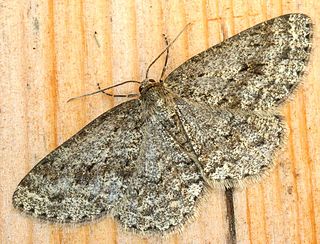
The engrailed and small engrailed are moths of the family Geometridae found from the British Isles through central and eastern Europe to the Russian Far East and Kazakhstan. The western Mediterranean and Asia Minor and the Caucasus represent the southern limit of the distribution. In the north, the distribution area ends at the Arctic Circle. It also occurs in North America. Debate exists as to whether they make up one species, or whether E. crepuscularia actually refers only to the small engrailed, with the engrailed proper being separable as E. bistortata.

The Thyatirinae, or false owlet moths, are a subfamily of the moth family Drepanidae with about 200 species described. Until recently, most classifications treated this group as a separate family called Thyatiridae.

Thallophaga hyperborea, the northern thallophaga, is a moth of the family Geometridae. The species was first described by George Duryea Hulst in 1900, and it can be found in the Canadian province of British Columbia.

Syngrapha abstrusa, the abstruse false looper, is a moth of the family Noctuidae. The species was first described by Thomas D. Eichlin and Hugh B. Cunningham in 1978. It is found in North America from Newfoundland to New Jersey, southern Canada, Montana and northern New Mexico.
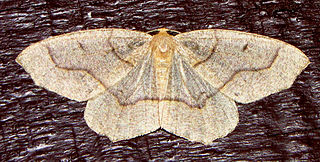
Lambdina fiscellaria, the mournful thorn or hemlock looper, is a moth of the family Geometridae. It is found in North America, from the Pacific to the Atlantic coast and from Canada south to Pennsylvania, Wisconsin and California.
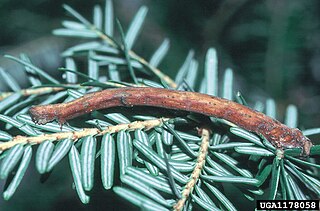
Pero morrisonaria, or Morrison's pero, is a moth of the family Geometridae. The species was first described by Henry Edwards in 1881. It is found from Newfoundland to British Columbia, and coast to coast in the northern United States, south in the east to South Carolina, south in the west to California.
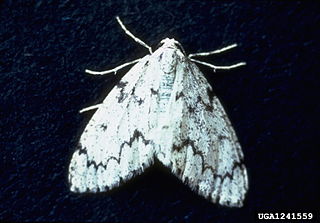
Nepytia freemani, the western false hemlock looper, is a moth of the family Geometridae. The species was first described by Eugene G. Munroe in 1963. It is found in North America from southern British Columbia and extreme southwestern Alberta south to Washington, Idaho, Montana and Utah.
Nepytia pellucidaria, the false pine looper, is a moth of the family Geometridae. The species was first described by Alpheus Spring Packard in 1873. It is found in Canada and the north-eastern parts of the United States.

Lambdina is a genus of moths in the family Geometridae first described by Hahn William Capps in 1943.

Neoalcis is a monotypic moth genus in the family Geometridae erected by James Halliday McDunnough in 1920. Its only species, Neoalcis californiaria, the brown-lined looper, was described by Packard in 1871.

Nepytia is a genus of moths in the family Geometridae first described by George Duryea Hulst in 1896.

Autographa ampla, the large looper moth, raspberry looper, brown-patched looper or broken-banded Y, is a moth of the family Noctuidae. The species was first described by Francis Walker in 1858. It is found in North America from Newfoundland west to the Alaska panhandle, south to central California, Arizona and New Mexico in the west and North Carolina in the east.
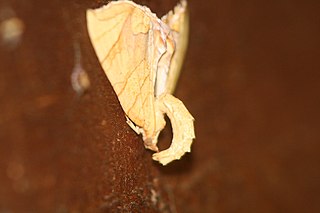
Eulithis gracilineata, the greater grapevine looper, is a moth of the family Geometridae. The species was first described by Achille Guenée in 1858. It is found from eastern Canada south to Florida. It has also been collected west to Saskatchewan and central Alberta, where it is rare.
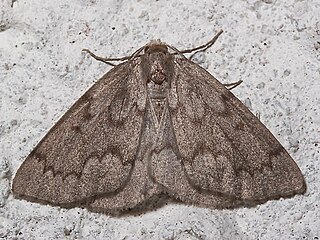
Nepytia semiclusaria, the southern nepytia, is a moth of the family Geometridae.
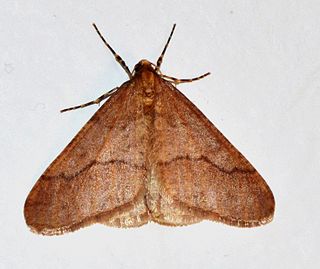
Erannis tiliaria, the linden looper, also known under the rather ambiguous name "winter moth", is a moth of the family Geometridae. The species was first described by Thaddeus William Harris in 1841. It is found in North America from central Alberta east to Nova Scotia, south to Missouri, Georgia, Utah and Texas.
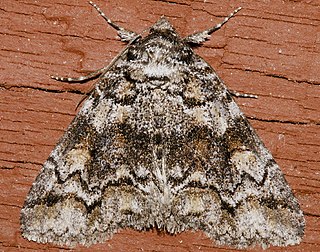
Zale duplicata, the pine false looper zale, pine false looper, banded similar-wing or grey similar-wing, is a moth of the family Noctuidae. The species was first described by Charles J. S. Bethune in 1865. It is found in woodlands and forests from British Columbia to Nova Scotia, south to the mountains of Georgia and Texas.

Nepytia umbrosaria is a moth of the family Geometridae first described by Alpheus Spring Packard in 1873. It is found in North America, including Arizona, British Columbia, California, Oklahoma, Oregon and Washington.
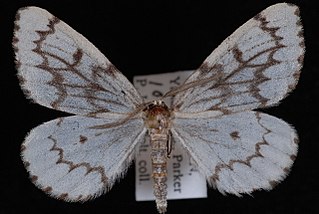
Nepytia phantasmaria, the phantom hemlock looper, is a species of geometrid moth in the family Geometridae. It was described by Herman Strecker in 1899 and is found in North America.
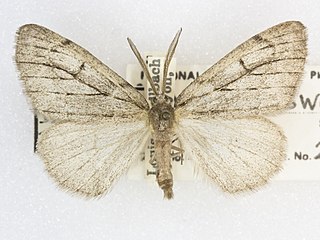
Nepytia swetti is a species of moth in the family Geometridae first described by William Barnes and Foster Hendrickson Benjamin in 1923. It is found in North America.



















